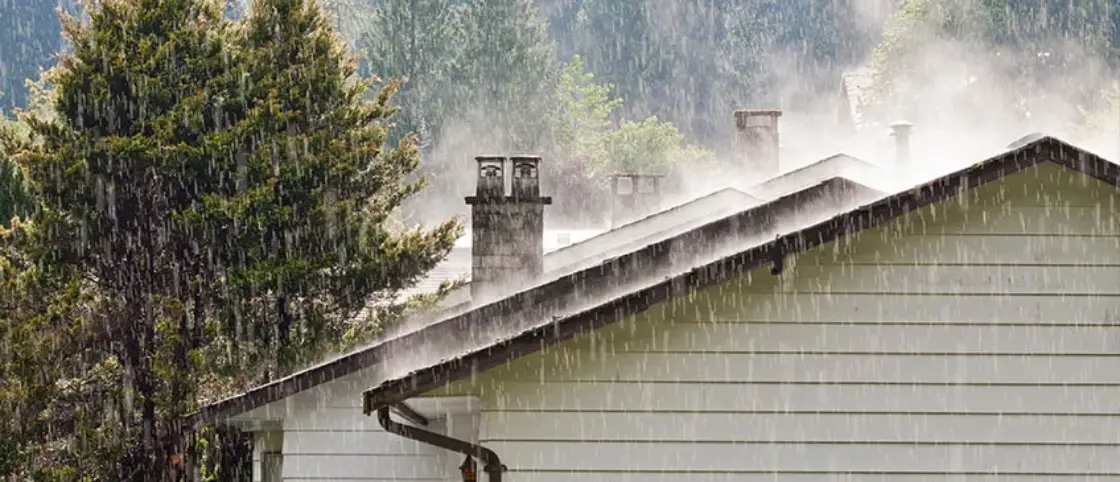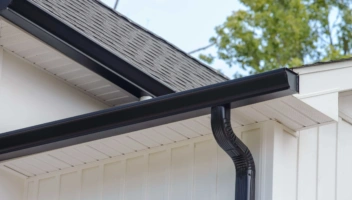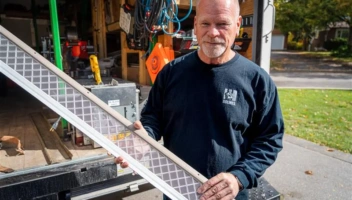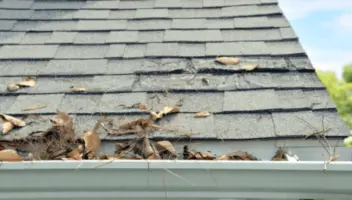Do Gutter Guards Work in Heavy Rain?

Homeowners often ask: Do gutter guards work in heavy rain? The answer is yes — but not all gutter guards are created equal. Performance depends on the type you choose and how it’s installed. While foam, brush, and basic screens often struggle during downpours, micromesh gutter guards stand out. Their fine material and design help block small debris while still letting large volumes of water pass through. Professionally installed, they’re one of the most reliable options for protecting your home from overflow.
In this guide, we’ll cover how different types of gutter guards perform in storms, which ones work best, and what to consider before choosing a system.
How Do Gutter Guards Perform in Heavy Rain?
In heavy rain, your gutter system needs to do two things at once: keep debris out and let large volumes of water pass through quickly. The right gutter guard can handle both jobs — helping prevent clogs that cause overflows while allowing stormwater to drain smoothly into downspouts.
Micromesh gutter guards are especially well-suited for this challenge. Their fine stainless steel mesh blocks even small particles, like pollen or shingle grit, while still letting water filter through. During a downpour, their angled design helps water follow its natural path into the gutter, helping reduce the chance of runoff spilling over the edge.
Other designs, such as reverse-curve guards or perforated aluminum screens, can also perform well if they’re installed correctly and kept clear of buildup. These systems rely on surface tension or larger openings to move water, but may allow more fine debris into the gutter, which can lead to blockages over time if maintenance is skipped.
Performance during storms also depends on factors like roof pitch, the amount of tree cover around your home, and how securely the guards are attached. A steep roof sends water down faster, increasing the volume your guards must handle. Homes surrounded by trees may see more debris accumulation, making regular post-storm checks important even with high-quality guards in place. Strong installation makes a difference, and LeafFilter’s internal hangers with a built-in pitch keep the guard secure while guiding water into the gutter, even in heavy rain.
🌧️ Heavy rain and debris can wreak havoc on your gutters. But with LeafFilter, you can put your mind at ease! Our product is made to handle all kinds of weather and keep your gutters clear. 🌪 See how it works at: https://t.co/wRb2LmHWVN #leaffilter #gutterguards #stormproof pic.twitter.com/Eszw1gJciL
— LeafFilter Gutter Protection (@LeafFilter) June 30, 2023
Best Gutter Guards Types for Storms
When heavy rain is in the forecast, the type of gutter guard you choose makes a big difference. Some designs are built to keep up with storm conditions, while others fall short. To help you see how the main options stack up, the chart below compares their ability to handle water flow, block debris, and minimize maintenance. Micromesh guards, including LeafFilter, consistently rank highest for storm performance. Here’s a comparison:
Comparison of Gutter Guard Performance in Heavy Rain
| Gutter Guard Type | Debris Blocking Ability | Water Handling in Heavy Rain | Maintenance Needs |
|---|---|---|---|
| Micromesh | Excellent: blocks fine particles like shingle grit and pollen | High: handles large water volume | Low: occasional post-storm check |
| Aluminum / Mesh Screen | Good: blocks most leaves and larger debris | Moderate to High: larger openings allow good flow but may admit small debris | Moderate: clean periodically |
| Reverse-Curve (Surface Tension) | Good: directs water into gutter while shedding debris | High: surface tension works well in downpours, but debris can build on edge | Moderate: seasonal cleaning |
| Brush Inserts | Fair: traps large debris but allows small particles in | Moderate: bristles slow water in extreme rain | High: frequent cleaning required |
| Foam Inserts | Fair: filters large debris, absorbs some small particles | Low to Moderate: can slow water in storms and trap moisture | High: prone to clogging and mold |
Micromesh Gutter Guards
Built from stainless steel or aluminum, micromesh guards use an ultra-fine screen to block everything from leaves to shingle grit. Their angled placement helps water slide in quickly, even when it’s coming down hard. Because they keep out such small particles, they’re also the least likely to clog, meaning less upkeep after a storm.
Aluminum or Mesh Screen Guards
These guards are often flat or slightly curved panels dotted with small openings. Hole size makes a difference: smaller holes block more debris but can slow intake, while larger holes boost flow but let fine particles through. A quality mesh guard will still manage strong rain, though it may need cleaning more often than a micromesh system.
Reverse-Curve (Surface Tension) Guards
With a smooth, rounded edge, reverse-curve guards guide rainwater into the gutter while leaves slide over the side. They rely on surface tension — water hugs the curve and drops into the gutter below. When installed at the right angle, they can handle a serious downpour, but smaller debris might cling to the edge or slip inside, so occasional cleaning is still necessary.
Brush Inserts
Brush-style guards look like oversized bottle brushes that sit inside the gutter. Leaves get caught on top of the bristles, while water trickles through to the gutter beneath. They’re simple to install and remove, but in heavy rain, the bristles can slow water enough to cause minor backups. Frequent cleaning keeps them from turning into a debris trap.
Foam Inserts
Made from porous foam cut to fit snugly in the gutter, these guards let water seep through while stopping larger debris. In a hard rain, the foam can saturate and slow the flow, which sometimes leads to overflow. They’re lightweight and inexpensive but can collect dirt and hold moisture, so they tend to need more frequent replacement or cleaning.
The Consequences of Overflowing Gutters
While you might think water flowing over the edges of the gutters is just an inconvenience, it can potentially cause significant water damage to your home. Overflowing gutters can lead to home water damage, such as:
- Foundation Damage: If water is pooling around the home’s foundation rather than being diverted away by the downspouts, it can actually penetrate the foundation over time. This can lead to cracks, leaks, and, in severe cases, structural damage.
- Basement Damage: Your basement can also flood from the pooling water. This can damage personal belongings and lead to mold growth.
- Damage to Siding: Siding and exterior damage is also a possible result from clogged gutters, leading to warping and the need for repairs.
- Landscape Erosion: Landscape erosion is another possible issue. Mild cases might only affect the appearance of landscaping, but if it keeps happening, plants can be damaged. It can even adversely affect the ground your home is built on, contributing to basement flooding and foundation issues. In addition, it can cause slippery spots by creating mud in warmer weather or freezing in cold weather.
- Roof Damage: If water is cascading over the edge of the gutters rather than diverting away from your home, it can also seep under your roof’s shingles and underlayment. This can lead to mold and mildew as well as leaks and other deterioration.
The best way to combat these issues is to prevent overflow as much as possible with a proven gutter protection solution like LeafFilter’s micromesh gutter guards. Our award-winning, patented technology provides a permanent solution to clogged gutters.
Pros and Cons of Gutter Guards in Heavy Rain
Even the best gutter guards have strengths and limitations, especially when storms roll in. Here’s a quick look at how they can help, and where you may still need to keep an eye on performance.
Why LeafFilter Performs Best in Heavy Rain
| LeafFilter Micromesh Guards | Other Gutter Guard Types |
|---|---|
| Keeps water flowing: Designed with a built-in pitch to guide rainwater into gutters efficiently. | Can struggle in downpours: Larger openings or poor fit may cause water to spill over. |
| Blocks fine debris: Stainless steel micromesh keeps out leaves, shingle grit, and pollen. | Allows buildup: Screens, foam, or brush inserts may let small particles through, leading to clogs. |
| Low maintenance: Only occasional post-storm checks are needed. | High upkeep: Many designs require frequent cleaning to stay clear. |
| Protects your home: Helps prevent water damage to fascia, siding, and foundations. | Risk of overflow damage: Poor performance can cause leaks, erosion, or roof issues. |
| Storm ready: Strong hangers keep the system secure during heavy rain and high winds. | Stability varies: Lighter or DIY systems may shift, warp, or detach in bad weather. |
Installation and Maintenance Tips to Keep Gutter Guards Performing in Heavy Rain
A quality gutter guard system will last longer and work more effectively if it’s installed correctly and checked periodically. We recommend keeping these things top of mind:
- Install with a gentle slope. Most pros recommend matching the pitch of the guard to the slope of your roof, or angling it just slightly downward. This helps water flow directly into the gutter while giving leaves and grit a better chance to slide off.
- Secure each section firmly. Guards should be anchored with durable screws or hidden hangers that attach to the fascia, not just clipped to the gutter lip. This helps prevent shifting during heavy rain, high winds, or seasonal storms.
- Inspect after major storms. Look for buildup on top of the guard and remove any leaves, twigs, or grit so water can continue to flow freely.
- Adjust maintenance to your environment. Properties with dense tree cover may need more frequent checks in the fall, while coastal homes may require inspections after wind-driven rain.
LeafFilter accounts for these factors with built-in pitch and internal hangers, and our professional installation means you don’t have to worry about angles or fastening.
Assessing Gutter Guard Suitability for Your Home
Every home is different, and so is every storm. The best gutter guard for you will depend on things like your roof pitch, how much rain you get in a season, the trees around your home, and what you’re comfortable spending. That’s why it’s important to choose a system designed for your home rather than a one-size-fits-all solution. With the right gutter guard in place, you can protect your roof, foundation, and landscaping from costly water damage and feel confident your home is ready for heavy rain, season after season.
Frequently Asked Questions
What is the best gutter guard for heavy rain?
Micromesh gutter guards, such as LeafFilter, are the most effective gutter guards for heavy rain. But you don’t have to take our word for it: LeafFilter has earned top recognition: Today’s Homeowner named us Best for Professional Installation and Cost, while EcoWatch rated us Best Overall Gutter Guard for Heavy Rain, and our customers agree!
What are the disadvantages of gutter guards?
Gutter guards work very well, and are generally beneficial. But there are a few potential downsides: firstly, the installation costs are an investment, and some people simply might not have available funds to set aside for gutter protection. (As a side note, we offer financing for our gutter systems.) Not all gutter guards are completely maintenance-free; however, micromesh gutter guards allow for the most minimal amount of maintenance.
Is it better to have gutter guards or not?
It’s absolutely better to have gutter guards than to not have them. From clogged gutters to leaks and sagging, having unprotected gutters can lead to many problems. Gutter cleaning just isn’t enough, and that’s true even if you hire a pro. Our gutter guard system is designed to keep your gutters clog-free for life and comes with a limited lifetime transferable warranty that can even add value to your home.
How long should gutter guards last?
It really depends on the type of gutter guard you buy. Most mass-produced, DIY options are lightweight and tend to wear out after just a few years. Professionally installed systems last much longer. LeafFilter’s micromesh guards typically last 10–20 years depending on your climate and weather conditions, and they’re backed by a transferable lifetime warranty for added peace of mind.
Can gutter guards prevent all clogs in heavy rain?
Although gutter guards can stop most debris, in a heavy downpour, bits of grit or seeds may still find their way in. With LeafFilter, however, your system is backed by a clog-free guarantee, giving you confidence that your gutters will keep working through the storm. A quick check after major weather is always a smart move.
How often should I inspect gutter guards after a storm?
If the weather’s been rough — high winds, pounding rain, lots of leaves — it’s worth checking as soon as it’s safe to do so (don’t use ladders in slippery, slick conditions). Look for water that seems to be backing up or piles of debris sitting on top of the guard. Catching small issues early keeps your system working at its best.
Do gutter guards work on curved or custom gutter shapes?
Yes. Many gutter guards, including LeafFilter, are designed to work with a variety of profiles, from standard K-style to curved or custom designs. The right fit is important for keeping performance strong in any weather.
Will gutter guards affect gutter capacity during heavy rain?
When they’re put on correctly, they shouldn’t slow water down at all. In fact, they can help by guiding the flow straight into the gutter. The real key is proper installation so that your gutters can stay cleared out over time.
Should I install gutter guards myself or hire a professional?
Some people take the DIY route, but climbing ladders and handling long panels isn’t for everyone. A pro will make sure the guard fits snugly and works with your roofline, so you get the protection you paid for without the risk. LeafFilter provides expert installation services customized to suit the specific needs of your home. Call our local gutter protection pros at 1-800-290-6106 to learn more and get your free estimate today!


